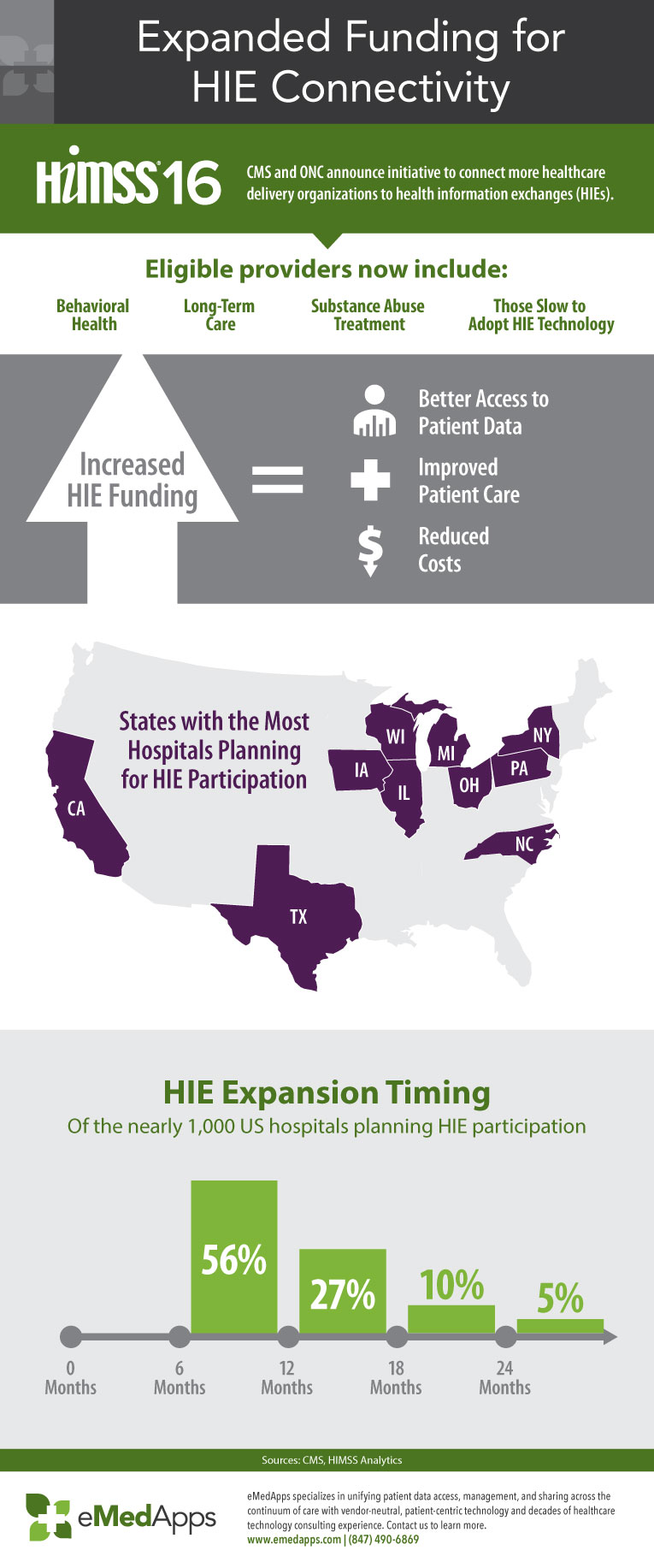Jun 20
2016
Expanded Funding for HIE Connectivity
Guest post by Joe Cernik, vice president business development, eMedApps.
CMS and ONC recently announced an initiative (read: funding) to connect a variety of providers to health information exchanges, expanding the list of eligible providers to include long-term care, behavioral health and substance abuse treatment providers. Meant to increase the sustainability of HIEs and support improved access to the right patient data at the right time, the increased funding supports categories of providers that have been slow to adopt HIE technology.
The intent of increased funding for HIEs translates to better, more comprehensive access to patient data, improved patient care and reduced costs.
From a recent CMS blog post: ‘The great promise of technology is to bring information to our fingertips, connect us to one another, improve our productivity, and create a platform for the next generation of innovations. Technology, when widely distributed and available, enables providers to improve patient care by distributing information and best practices leading to better experiences of care for individuals in the health care system.” *
What does expanded funding for HIE connectivity mean for patients and providers?
One organization making the most of the initiative is the Massachusetts League of Community Health Centers, the statewide primary care association representing and serving the needs of the state’s 49 community health centers (CHCs). This organization partnered with eMedApps (infographic author below), to define a programmatic approach to onboarding CHCs to the IHE and extending the value of the funding increase.
Ellen Hafer, MTS, MBA executive vice president and chief operating officer for the Massachusetts League of Community Health Centers, shared her insight and experience connecting disparate providers to the Mass HiWay: “Health information exchange is critical as I envision it for quality of care in the short run now as well as the long run. Much of those benefits revolve around connecting disparate aspects of the care continuum at the community-health level. Community Health Centers (CHCs) are often independent organizations who serve as primary care providers, social support agencies and economic engines transforming their communities, one patient at a time. Many offer integrated care, but it’s across the spectrum of clinical specialties like behavioral health or oral health and not necessarily the full complexity of medical specialties. The information connection to behavioral health and substance abuse treatment in high risk populations extends the care continuum where it’s needed.”
The Mass HIway acts as a Health Information Exchange (HIE) between organizations and offers doctors’ offices, hospitals, laboratories, pharmacies, skilled nursing facilities and other healthcare organizations a way to securely network and seamlessly transmit patient data electronically. Massachusetts requires all medical providers become part of an HIE connected to the Mass HIway by 2017 to improve the speed, quality, safety and cost of patient care in Massachusetts.
Mass League saw the need to refer patients for a specialty tier, because a lot of their population is fairly high risk and needs to access care. As a result of the interoperability communication program efforts, the referral process is improving. Also that same population has heavy engagement with emergency rooms. Emergency department overuse is an enormous, expensive issue nationally. Mass League used the initiative to connect to area hospitals and emergency departments to follow up quickly with patients and help get them moved into more solid practice of primary care.
Hafer further commented, “As part of our program, we are now connected and able to do referrals to YMCAs for nutrition programs, and follow up around hypertension helping patients with exercise other lifestyle choices to better manage their hypertension. We’re engaging more community health workers in outreach for improved compliance with patients to utilize resources that may be as effective as medical interventions or to augment medical interventions.”
Because of the Mass League HIE connectivity program, physicians and providers gain important community support in many interventions. The key to success involved connecting all the pieces, bi-directionally. Community activity and support includes referrals for things like housing needs and other non-medical but necessary elements of care. The program is helping Mass League tackle some of the social “determinates” of health that affect their patient population to a greater degree.”
